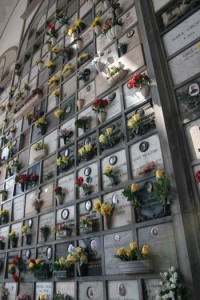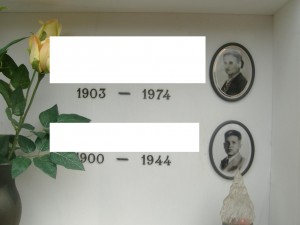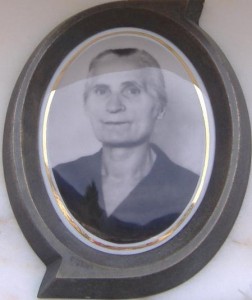Gravestones: The Disparate Couple March 5, 2012
Author: Beach Combing | in : Contemporary , trackbackBeachcombing has a thing about Italian cemeteries, which tend to be far more gaudy than their British equivalents, but are often also more moving. There the visitor will find paper or fabric flowers on every tomb, photographs of the resident dead, the graves cared for on an almost weekly basis by relatives, the ‘Christmas lights’ that come on as twilight closes in, the strict segregation of graveyard and settlement – the old Roman notion that the departed are both powerful and unstable, a notion that is so alien to the Anglo-Saxon world…
After his recent post on witty gravestones Beach went to a couple of Italian cemeteries in search of Italian inspiration. He found none: texts are sparse and wit would be seen as bad taste here. But he did find another phenomenon that has haunted him all week: let’s call it ‘the disparate couple’.
Man and wife are often buried together in Italy, as is the case in many parts of the world. And, inevitably, there is an interval between the interment of one and the interment of another. The fact that men tend to marry women who are slightly younger and that women, anyway, outlive men means that very often the man is plastered into the wall (Italian graves are typically vertical) and is then only joined by his dutiful wife five or ten years later.
However, let’s say that a husband dies in his thirties or forties and that his wife lives on into her eighties. Today, the interval would be problematic for several reasons: not least that the wife might marry again. The link between man and wife is not, in theological terms, eternal in any case unless you happen to be a Mormon. And Beachcombing would bet that very few wives dying forty years after their husbands would be buried with special reference to the loves of their younger lives.
But Beachcombing is associated in Italy with a series of traditional villages, villages that have remained loyal to the old ways: pregnant teens get married, divorce is frowned upon, if you buy birth control don’t go to the village pharmacy…
And this is reflected in several graves where a wife has, indeed, been buried next to her husband forty years later. These gravestones are particularly poignant because the age difference is brought out not just by the numbers but by the photographs. Any other similar graves? drbeachcombing AT yahoo dot com
Both men in these images died in the Second World War. Their exact fate is not recorded but 1942 – 1944 were the years when resistance to Mussolini and latterly the Germans was growing, when the Italian population was reduced to starvation diets of 1000 calories a day, and when, 1943-1944, a low-key civil war broke out between Fascist Italians and their Anti-Fascist co-nationals.
It is not necessary that either died as a result of the war, but thinking of their sex and age it is likely, particularly given the ferocity of conflict in Beachcombing’s area: a secret room abutting the study where this post was written was used by Catholic partisans in the last months of the German occupation.
In any case, an Italian woman of this generation would have found it almost impossible to marry again even had she wanted to and come the 1970s and 1980s the wives were laid to rest here in peace next to their husbands of a generation before.
Beachcombing has not the slightest belief in any conventional form of afterlife. He can’t take reincarnation seriously. Perhaps the ‘spirit’ survives death but not the personality? However, looking at these photographs several childish questions come to him.
If we do make it to another world what age are we there? If Beachcombing stumbles across his grandmother will she be in her eighties, as she was the last time he saw her, or in the full bloom of middle age playing volley ball and winning egg and spoon races? Will the Italian couples pictured here even recognise each other in this unlikely second meeting?
Cue lots of medieval debates about the age of the soul in the next life: 33 the age of Christ at his death was often employed as a point of pontification.







